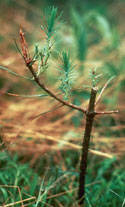Coping with Damage Caused by Wildlife

Rapid growth of the human population in Florida has resulted in the conversion of natural lands to areas with more intensive uses (agricultural fields, orchards, forest plantations) and more dense human populations (suburban and urban areas). These conversions force wildlife to either become concentrated in ever-shrinking natural areas or adapt to the more intensively managed landscape. Unfortunately, when wildlife utilize farms, orchards, and plantations to meet some of their nutritional needs, they can become a nuisance. In extreme circumstances, landowners may incur significant economic hardship as a result of wildlife feeding on crops.
Although there are no sure-fire ways to eradicate wildlife feeding, strategies have been developed to minimize some of the problems wildlife cause. General factors that should be given consideration by forest landowners and managers experiencing nuisance wildlife issues include the following:
- Deer damage to crops, fruit trees, and ornamental plants tends to be fairly sporadic, occurring during those times of the year when native foods are limited in abundance. This is good news, because many of the “scare tactics” that have been developed to deter nuisance wildlife are effective for only short periods of time (until the animals become habituated to the scare factor). Use of a scare tactic for a short period may effectively solve the problem.
- The presence of high-protein crops such as peanuts and soybeans can attract white-tailed deer to an area. They may then feed on other cultivated plants in the vicinity. In areas where deer damage is severe, consider planting a different crop or limiting these highly attractive crops to locations that experience high human traffic so the deer are frequently disturbed when near these plants.
- Seedlings can be protected from browsing by deer or beaver with plastic tubing. However, this technique is unlikely to deter feral hogs.
- Feral hogs feed on both pine seedlings and seeds, inhibiting natural regeneration of longleaf pine. Control methods for hogs include hunting, trapping, and exclusion.
Managing Forests
for Wildlife
- Managing Forests to Promote Game Species
- Managing forests to promote biodiversity
- Coping with damage caused by wildlife
- Sources of assistance for forest landowners
UF Publications
- Coping with deer damage in Florida
- Control and management of wild hogs in Florida
- Beavers of Florida
- Living with the Florida black bear
